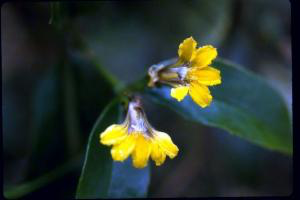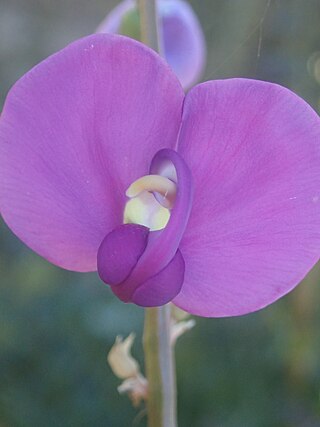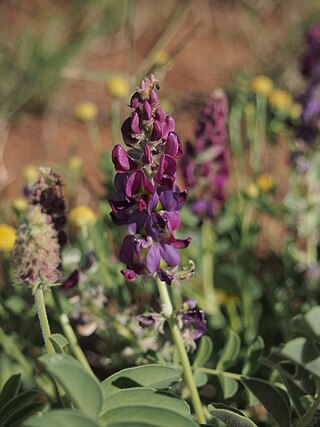
Rutidosis leptorrhynchoides, commonly known as button wrinklewort, is a flowering plant in the family Asteraceae. It is an upright, tufted, perennial herb with bright green leaves and yellow button-shaped flowers.

Spyridium parvifolium, commonly known dusty miller, is a flowering plant in the family Rhamnaceae. It has dark green leaves and clusters of small, whitish flowers at the end of branches. It is widespread in eastern states of Australia.

Hovea acanthoclada, commonly known as thorny hovea, is a flowering plant in the family Fabaceae. It is an upright, prickly shrub with small dark green leaves and purple-blue pea flowers in winter and spring. It is endemic to the south-west of Western Australia.

Stackhousia monogyna, commonly known as creamy stackhousia or creamy candles, is a flowering plant in the family Celastraceae. It is a small multi-stemmed plant with narrow leaves and terminal spikes of white, cream or yellow flowers. It is a widespread species found in all states of Australia but not the Northern Territory.

Darwinia micropetala, commonly known as small darwinia, is a species of flowering plant in the family Myrtaceae and is endemic to south-eastern continental Australia. It is a small, erect shrub with linear leaves, and heads of white to pink flowers.

Prostanthera walteri, commonly known as blotchy mint-bush, is a species of flowering plant that is endemic to south-eastern Australia. It is a sprawling shrub with tangled, hairy branches, egg-shaped leaves and usually bluish green flowers with prominent purple veins arranged singly in leaf axils.

Podolobium aciculiferum, commonly known as needle shaggy-pea, is a flowering plant in the family Fabaceae and endemic to eastern Australia. It has stiff, pointed leaves and yellow pea-like flowers with red markings.
Conospermum toddii, commonly known as Victoria Desert smokebush, is a species of flowering plant in the family Proteaceae and is endemic to inland areas of Western Australia. It is a spreading shrub with thread-like leaves, panicles of white, tube-shaped flowers and hairy nuts.

Eulophia venosa, commonly known as the pointed corduroy orchid, is a plant in the orchid family and is native to India, parts of Southeast Asia as well as New Guinea and northern Australia. It is a deciduous, terrestrial orchid with one large and one small leaf and between six and twenty pale green or yellowish flowers with purple markings. It grows in rainforest and grassy forests.

Scaevola enantophylla, commonly known as climbing fan-flower,is a species of flowering plant in the family Goodeniaceae and is endemic to Queensland. It is a scrambling vine with yellow fan-shaped flowers, and the only species in the genus with leaves arranged opposite.

Brachyscome graminea, commonly known as grass daisy, is a perennial herb in the family Asteraceae and is endemic to Australia. It has mostly mauve-pink or purple daisy-like flowers and a yellow centre.

Bossiaea decumbens is a spreading, prostrate shrub in the pea family (Fabaceae), and is endemic to Victoria. It has alternate, variable shaped leaves and yellow pea flowers with red splotches from spring to late summer.

Leionema oldfieldii is a small shrub that is endemic to mountainous locations in Tasmania, Australia. It has dark green leaves, compact pale pink to white flowers from November to January.

Swainsona procumbens, commonly known as Broughton pea or swamp pea is a species of flowering plant in the pea family (Fabaceae), and is native to Australia. It is a spreading or ascending perennial shrub-like herb with imparipinnate leaves with 15 to 25 linear to narrowly lance-shaped leaflets with the narrower end towards the base, and racemes of 2 to 12 purple or mauve to pink flowers.

Rhadinothamnus euphemiae, is a slender, small, upright shrub with needle-shaped branchlets thickly covered with silvery scales and tubular greenish-purple tubular flowers throughout the year. It is endemic to the south coast of Western Australia.

Hemigenia teretiuscula is a species of flowering plant in the family Lamiaceae and is endemic to the southwest of Western Australia. It is an upright, glabrous shrub that typically grows to a height of 10–80 cm (3.9–31.5 in), the leaves about 1 mm (0.039 in) in diameter, more or less tapering cylindrical and somewhat sharply pointed. Flowering usually occurs from August to December and the flowers are bluish-purple.

Commersonia magniflora is a species of flowering plant in the family Malvaceae and endemic to Australia. It is an erect shrub with wrinkled, narrowly oblong to elliptic or egg-shaped leaves, and deep pink flowers.

Swainsona canescens, commonly known as grey swainsona, is a flowering plant in the family Fabaceae. It is a small perennial herb with pink-purple or purple, yellow and green flowers and grows in Queensland, Western Australia and South Australia.

Podolepis hieracioides commonly known as long podolepis, is a flowering plant in the family Asteraceae and grows in New South Wales and Victoria. It is a small perennial with yellow flowers.
Leptorhynchos baileyi, commonly known as woolly buttons, is a species of flowering plant in the family Asteraceae. It is an erect to ascending annual herb with linear leaves and yellow flowers.


















